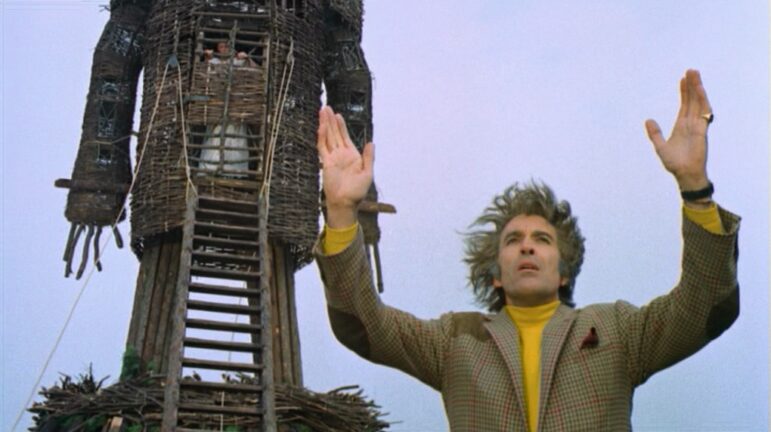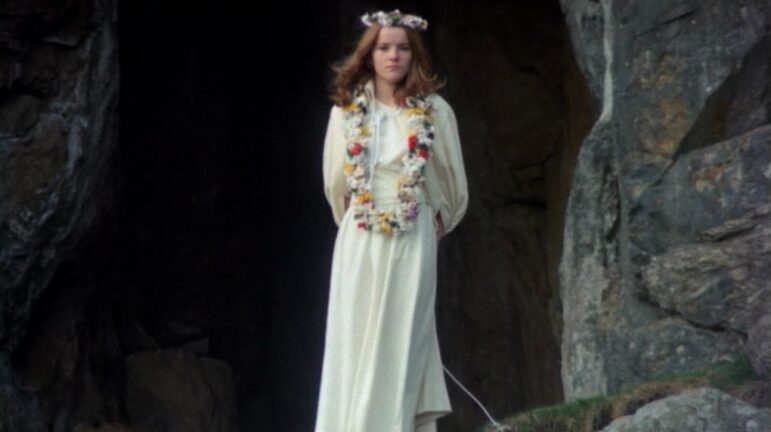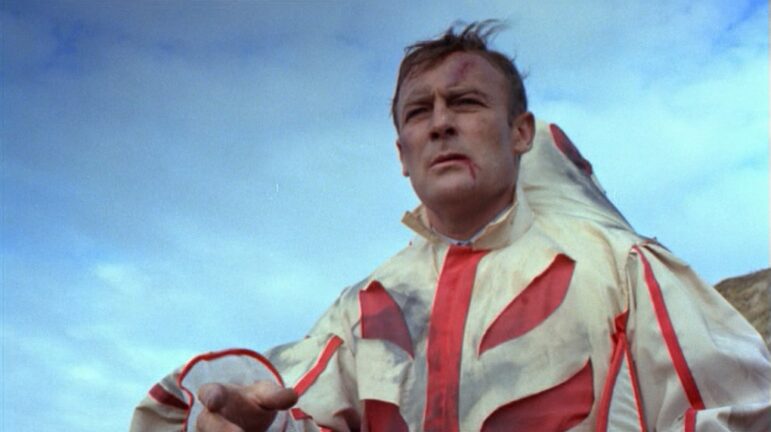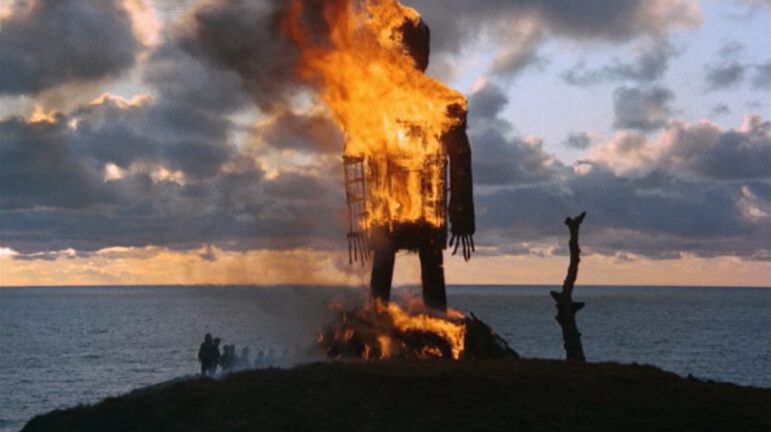
When I was in my early 20s, I stayed with my coven-sister in Kansas City for a weekend while I went looking for an apartment. She had a photograph of Christopher Lee as Lord Summerisle hanging on a wall of her apartment, a still of him in his tweed jacket and his wild hair, his arms raised to offer his sacrifice to the gods of sun and field. I could see the photograph from where I lay on her couch, and his eyes seemed to follow me as I tossed and turned, trying to fall asleep in the hot summer night. In the morning I asked her what made her hang that particular image in her room. Because I’d give anything to go to Summerisle, she said, smiling brightly. Wouldn’t you?

Christopher Lee as Lord Summerisle in Robin Hardy’s “The Wicker Man” (1973) [Studiocanal]
Robin Hardy’s The Wicker Man (1973) is, of course, the iconic film of what we might called “Pagan cinema.” Although it was neither the first film to include real-world occultism, nor the first example of what’s come to be called “folk horror,” The Wicker Man set the template for so much of Paganism in film that followed that it’s hard to think of an example of a “Pagan movie” that isn’t in conversation with Hardy’s film. It was the first film I thought of when I pitched this series of reviews and one of the only films that seems to show up on the list of everyone else I’ve spoken to about the series.
And it’s that very reputation that makes The Wicker Man intimidating to write about. What new is there to say? But this month’s release of the 50th-anniversary restoration of the film on 4K and Blu-Ray invited a new look at the film and an opportunity to evaluate what it means for Paganism in cinema.
The story, as written by Anthony Shaffer, begins with Sgt. Howie, a Scottish police officer, played to perfection by Edward Woodward. Howie is a man of strong convictions, a devout Christian, and a loyal subject of the Crown. He is also a difficult man to love, humorless and self-righteous, and to some extent a bigot against anything that does not conform to his preconceptions.
The plot unfolds as Sgt. Howie receives an anonymous letter from Summerisle, a private island off the Scottish coast, claiming that a 12-year-old girl, Rowan Morrison, has gone missing. Howie arrives on the island via police seaplane and begins to investigate the girl’s disappearance, only to find his work obstructed by the locals, who claim that there never was a Rowan Morrison on the island — or perhaps that Rowan was a hare, or a body in the graveyard, or something altogether more sinister.
What has made the film irresistible to Pagans for the past half-century is its depiction of life on Summerisle, where Christianity has been forgotten and replaced with what the inhabitants call simply “the Old Religion.” As Howie explores the island, he finds schoolchildren being taught of the phallic associations of the Maypole, young women jumping over bonfires hoping to bear the children of gods, and a church long abandoned and given over to nature. The religion of Summerisle is a fertility cult, devoted to both human fecundity and the prosperity of the island’s famous orchards, their primary export and apparent backbone of the local economy.
Ah, yes, the economy. More than anything, it was the economy of Summerisle that troubled me as I watched the film again for this review. Summerisle is strangely full of labels and brand names – Heinz Beans, Smirnoff Vodka, Kodak film — and the locals are dressed not in some medieval throwback garb, but in clothes that 50 years on can only be described as unmistakably of the 1970s. The plot is motivated by the nature of Summerisle’s agricultural commodities.
Far from being a forgotten and isolated enclave, Summerisle is clearly intertwined with the rest of Scotland and the broader world, making its Pagan culture all the more troubling. How does one export apples and import bright yellow turtlenecks without exposing oneself to the pressures to conform to the outside world? This time I came away from Summerisle feeling it was less of an Otherworld and more of a place caught in the tides of history, too primitive and too modern all at once.

Gerry Cowper as Rowan Morrison in Robin Hardy’s “The Wicker Man” (1973) [Studiocanal]
It seems to me that the film revolves around two scenes that, as many times as I’ve watched them, maintain an incredible power. The first is Howie’s initial encounter with Lord Summerisle, where the police sergeant ventures into the Lord’s manor and learns the history of the island. For a scene that amounts to two British men discussing religion and botany, it’s wonderfully compelling. Lord Summerisle’s manor is covered in Victoriana and imperial remnants, the one place on the island that truly does feel like it’s of another time.
Howie has come to Lord Summerisle because he believes that the girl Rowan has been murdered, and worse than that, there is a conspiracy to cover it up. Lord Summerisle scoffs at the notion that he or his subjects — does Summerisle elect anyone to Parliament, I wonder? — could participate in such dark business: “We’re a deeply religious people.” “Religious? With ruined churches? No ministers? No priests?” says Howie, angry and shaken. He cannot contemplate the idea of a religion that looks different from his own.
Lord Summerisle explains the reintroduction of Paganism to the island in shockingly frank terms. His grandfather, he says, purchased the island a century before, having developed a new set of apple cultivars that could stand up to the harsh conditions of the northern climate. Seeking to bring the island’s “profuse supply of wiry labor” to heel, he brought Paganism to the island and encouraged the islanders to adopt its lusty, life-affirming ways.
The tradition continued after the old man’s death: “What my grandfather started out of expediency, my father continued out of love,” says Lord Summerisle. “He brought you up to be a Pagan!” cries Howie, leading to a famous retort: “A heathen, conceivably, but not, I hope, an unenlightened one.”
Beneath the witty banter, it’s still amazing to me how plainly Lord Summerisle admits to the craven origin of his “Old Religion.” His grandfather did not believe in the old gods; they were a useful tool to pacify his apple-pickers. The current Lord Summerisle knows this, and believes in the old gods anyway. It’s a candid assessment of the truth of the Pagan revival a quarter of a century before Ronald Hutton‘s Triumph of the Moon, one that acknowledges the complexity of its origins without denying Paganism any of its majesty or awful power.
The second great scene is of Willow the landlord’s daughter attempting to seduce Howie, one of the most achingly horny sequences in the history of cinema. It’s the end of Howie’s second night on the island. He kneels to pray, thinking back to reading in his home church back on the mainland, back where the world still works as it should. He thinks he has just pieced together all the threads of the mystery — that Rowan will be offered as a sacrifice to propitiate the gods after a failed harvest.
And then he hears Willow’s voice calling out to him through the thin walls of the inn: “I’m here,” she sings. “Am I not young and fair?” She moves with a magickal purpose, her hands seeming to clasp some erotic power to her breast, which she brings to the window and releases into the night.
This scene, it should be said, is a testament to the power of editing. For one thing, Willow is literally a dream girl, a gestalt of four different actresses: while Britt Eklund quite rightly gets the credit for the part, her speaking voice belongs to a second actress who had a better Scottish accent, her singing voice to a third, and, infamously, her bottom to a fourth, a body double who was kept secret from Eklund during filming.
For another, the placement of this scene is one of the most drastic differences between the different cuts of the film. In the “theatrical cut,” Howie only spends two days on the island, so Willow attempts to seduce him almost as soon as he arrives — before he meets Lord Summerisle or really learns anything about the island or its culture. While it’s still unforgettable, the audience has no real understanding of what’s going on and it’s hard to believe that Howie would be genuinely tempted.
By contrast, in the “final cut,” which I recommend, Howie has spied the lord bringing a virgin boy to Willow’s window the night before, and heard the sounds of his sexual initiation with her. (“Another sacrifice for Aphrodite,” says Lord Summerisle.) In this version, Howie has spent two days being exposed to the wild delights of Pagan life and knows exactly what Willow is offering. He presses his brow, beaded with sweat, against the wall, his hand separated from the local manifestation of the goddess only by a few inches of plaster. “Would you have a wondrous sight?” she sings to him, and we can see just how he aches to accept it.
But he does not. He maintains his chastity. He refuses to give in to his lust. He is a man of virtue. In many movies, this would be the moment at which our hero passes his great test of character, and proves himself worthy of his reward.
Perhaps such is true in this story as well.

Edward Woodward as Sgt. Howie, dressed in the clothes of Punch the Fool, in Robin Hardy’s “The Wicker Man” (1973 [Studiocanal]
In the documentary Burnt Offering: The Cult of The Wicker Man, Seamus Flannery, the film’s art director, quipped that The Wicker Man had been written as a melodrama, shot as a musical, and won the award for Best Science Fiction Film of its year. To this assortment of genres, let me offer one more: noir.
In his book Somewhere in the Night: Film Noir and the American City, Nicholas Christopher argues this essential definition of the film noir: “The hero enters a labyrinth on a quest. He is alone and off-balance. He may be desperate, in flight, or coldly calculating, imagining he is the pursuer rather than the pursued… He descends downward, into an underworld, on a spiral. The object of his quest is elusive, often an illusion. Usually he is destroyed in one of the labyrinth’s innermost cells, by agents of a larger design of which he is only dimly aware.”
Although noir is a genre customarily concerned with darkness, urbanity, and America, and The Wicker Man is a film about daylight, rural life, and the British Isles, still the form holds. Howie is driven deeper and deeper into the labyrinth of Summerisle, culminating in an exhilarating sequence in which he infiltrates the island’s May Day celebrations, chasing a Hobby-Horse through the labyrinth of the village’s back alleys. Howie is chasing after Rowan Morrison, hoping he can find where the villagers have hidden her before she is sacrificed to their barbarian gods. He is dressed in the clothes of Punch the Fool, but never realizes that he has been playing that part much longer than he has had the costume.
We know where this leads; it’s the name of the film, after all. Howie finds the girl and leads her away from her captors, a comically upbeat rock guitar line accompanying them. But he does not find safety or reinforcements waiting for him. Instead, he finds Rowan’s mother, into whose arms the girl gratefully runs. He finds Lord Summerisle and Willow and the rest of the villagers. And he finds the Wicker Man.
As Lord Summerisle explains, the entire mystery surrounding Rowan Morrison has been a phantom; the real purpose was to bring Howie to the island. Throughout the film Howie is tested in secret, and proves himself again and again: a virgin who maintained his chastity against Willow’s temptations; an officer of the law with the power of a king; a man who comes of his own free will. (That last part seems debatable.) The villagers bind him inside the wicker effigy and burn him alive, conferring upon him a “rare gift,” according to Lord Summerisle — “a martyr’s death.”

The burning of the Wicker Man in Robin Hardy’s “The Wicker Man” (1973) [Studiocanal]
For horror fans, the finale of The Wicker Man is legendary, a twist ending that reveals itself as cruelly inevitable on repeated viewings. For a Pagan audience, it’s more complicated.
I have myself attended sabbat rituals that were clearly influenced by the final scenes of The Wicker Man, where we built tall effigies out of straw and set them aflame at the close of day – though I must note ours contained neither animal nor human sacrifices.
More broadly, the imagery of Summerisle has colored the Pagan Revival for decades. Figures like Vivianne Crowley saw the film in its original run and were “astonished” to see Paganism “given a serious role in this movie even if some of the presentations weren’t particularly positive.” I don’t think we could quite imagine what our movement would look like today without The Wicker Man.
This has meant that Pagan cinema has largely been a cinema in which we are the villains — sympathetic villains, sometimes, who express desires and perspectives that Christianity has repressed, but villains nonetheless. The people of Summerisle burn a man alive, it must be remembered — they seize him and bind him and set him aflame, and they do it with a joyous song on their lips. It is impossible for me not to see this magnificent tribute to the gods of sun and earth and not long for it, just as my coven-sister does; it is just as impossible for me not to feel horror at my own longing. Such is true for the many Pagan films descended from this one.
We might ask, does the ceremony work? Does Howie’s death bring the apples back, or will, as he shouts to the mob, they be burning their lord in the Wicker Man next year? The film does not say whether or not he is right, and for me, that ambiguity is what appeals. There are only two possibilities: that the crowd burnt a man alive for nothing, or that the crowd burnt him alive for the sake of apples.
Which of these would be the greater horror — that magic does not exist, or that it does?
Author’s note: This review is based on the just-released U.K. Vintage Classics 4K release of the 50th-anniversary edition of The Wicker Man, which includes three cuts of the film (the “theatrical,” “director’s,” and “final” cuts) and many special features, including Burnt Offering.
The Wild Hunt is not responsible for links to external content.
To join a conversation on this post:
Visit our The Wild Hunt subreddit! Point your favorite browser to https://www.reddit.com/r/The_Wild_Hunt_News/, then click “JOIN”. Make sure to click the bell, too, to be notified of new articles posted to our subreddit.